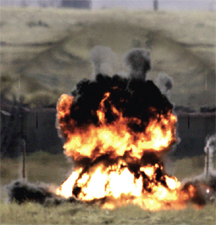
At the end of a long, dusty gravel road, behind yellow barricades that warn wanderers away from active testing sites, a group of scientists from Sandia, two Canadian institutions, and experts from the UK are conducting experiments to better understand what happens on the ground and in the air when explosives detonate on specific surfaces.
After the second five-pound charge of the day detonates, the group receives the all-clear to investigate the blast site.
“Bit of a shelf in that crater,” remarks John Marriage from the Atomic Weapons Establishment in the UK. Fred Harper (6417), senior scientist in High Consequence Assessment and Technology, feigns skepticism. “That’s half a shelf, at best,” he teases.
Testing allows scientists to better predict the consequences of explosive and nonexplosive radioactive dispersal devices (RDDs). The purpose of this series of tests performed at the 9920 test site was to learn more about the interactions between explosive fireballs and different ground surfaces and to better characterize the buoyant behavior of the resulting plumes. This information will be combined with the results of the explosive aerosolization work that has been performed at the 9920 test site to understand the impact of RDDs detonated in urban environments.
Much of Fred’s work has been in indoor experiments. Working with the Canadian teams and the UK experts allowed him to bring his work outdoors to study different aspects of dispersal.
Other Sandians involved in the testing include Will Wente, Paul Johnson, Mark Naro, Weldon Teague, Roger Goode, Chris Parchert, Lindsay Dvorak (all 6417), Byron Demosthenous (1535), and Gary Zender (1822).
“The soot and dust swept into the fireball can combine to change the nature of the aerosol originally produced by the dispersal device,” Fred says. “This can significantly change the impact on the population. The indoor experiments are done on a smaller scale in a clean environment, and tell you what is produced after the interaction between the material and the shock wave on the microsecond time scale.
“The outdoor experiments tell you what happens to the material when it is exposed to soot and dust in the fireball on the millisecond time scale and how high the material initially rises on the second time scale.”
During this round of testing, 50 one-, five-, and 10-pound charges were detonated on asphalt, concrete, grass, play sand, loose dirt, and packed dirt so scientists could study the characteristics of the resulting debris clouds and the resulting surface damage.
After each explosion, the Canadian team tracked the resulting plume with a light detection and ranging (lidar) system that provides a four-dimensional model of the plume’s progress.
The lidar system is similar to Doppler weather forecasting systems. It generates a four-dimensional map that includes plume information about density, distance, and dispersion over time.
Each test tracks the movements of debris plumes for up to seven minutes. This allows researchers to better understand how variables like wind, explosive charge size, and the impacted surface affect the quality of materials released into the air and the rate at which they travel.
After the plume disperses, the UK team characterizes the resulting impact crater on a variety of surfaces including hard-packed dirt, sand, concrete, grass, and steel plates.
Gilles Roy from Defence R&D, Valcartier, says the lidar “sees more particles for a longer period of time than other systems.” The Canadians drove the lidar system with the delicate instrumentation on top all the way from Quebec, Canada, for the tests.
This is the Canadian team’s seventh trip to Sandia. Roy’s colleague Patrick Brousseau says that since Fred’s group had already done considerable research in the field, it seemed logical to share information to advance knowledge in the field without duplicating effort. The research programs and facilities in Canada were modeled after the program at Sandia.
Brousseau says work such as Fred’s helped them get into the field of detecting and analyzing radiological threats. He also says that after 9/11, the Canadian government decided it was something they should study further for their own national security.
Project team members from the Royal Military College of Canada and Environment Canada are using the measurements of the plume evolution to validate atmospheric dispersal models. Information coming out of these joint experiments is used by the health ministry in Canada to model biological effects of radiological dispersals.
John Marriage says work such as this provides emergency preparedness personnel and first-responders invaluable data to identify potentially dangerous source items.